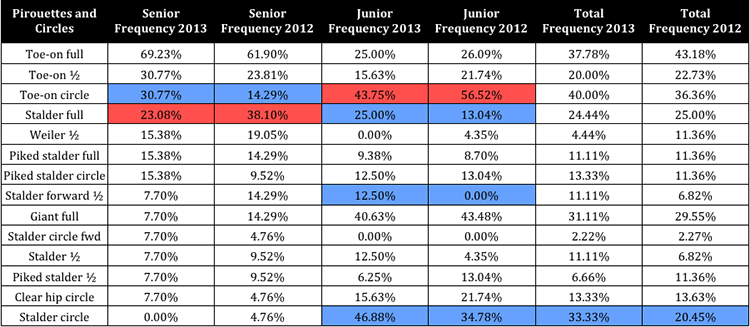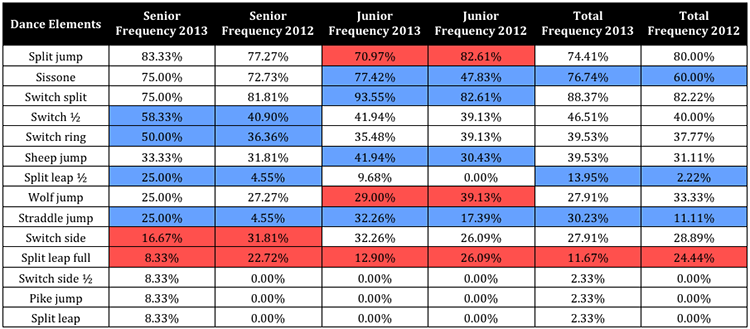So, here we go. While you take a break from speculating about McKayla Maroney's bars capabilities and Aliya Mustafina's floor endurance, enjoy some charts. With colors! The colors are supposed to be red and blue, but you never know with me, so if they're actually purple and orange, just deal with it.
As before, the percentages next to the skills indicate the proportion of gymnasts who performed each skill at National Championships, and skills are sorted by the frequency of their appearances in 2013 senior routines. Some basic skills like giant swings and back handsprings are not included because, obviously 100%. Numbers from 2013 and 2012 are listed side-by-side for easy comparison. Cells highlighted in blue reflect an increase in frequency of at least 10 percentage points over 2012, while cells highlighted in red reflect a decrease of at least the same amount. For the most part, any change less than that is statistically insignificant given the small number of routines we're working with (especially for the seniors). Even some of the larger changes may be attributable to normal variation in routine construction rather than code influence, but I'll talk through some of the larger changes as we go.
NOTES: Because there were so many more juniors, the junior routines have a much larger bearing on the total frequency column. Also, the charts include only skills performed during 2013 Nationals. Many skills dropped off the charts from 2012, but none that were performed more than one or two times last year. I didn't do vault because it's fairly straightforward. Yurchenko land. I classified the skills by what was attempted rather than what would actually be credited because this is about intended composition.
UNEVEN BARS
The toe-on full continues to reign as the D pirouetting skill of choice. Even though this code emphasizes release+release combinations, the toe-on full is still a valuable tool connected to a tkatchev or transition for .1 CV.
What's interesting is that the trend favoring toe-on skills over stalder skills seems to be increasing for the seniors, but the opposite is taking place for the juniors. There is a marked increase in the frequency of several of the stalder skills for the juniors. I'm not sure if there is a tangible reason for that, but it's happening. It should be noted that the large majority of those junior stalder fulls might be finishing their turns sometime by the end of the year. Maybe.
So, the Gienger died. That's weird, right? Very abrupt and very dead. The Jaeger just consumed it, apparently. Natural selection. We saw tons of toe-on Tkatchevs this year from the seniors. There are still fewer E releases being performed than I would expect given the new code, but it's early days, and this was not a particularly astounding bars group. They were just happy to get their jaegers in and get out of there.
It's working! Well, a little bit. The much-needed removal of the D+C bail handstand+stalder shoot connection bonus has had a distinct and measurable influence in decreasing the amount of stalder shoots we're seeing, but there were still far too many bail+stalders for my liking. STOP IT! You're not even getting CV. Many of the seniors are still doing the combo because they need the bail in their routine, and they've always done the stalder shoot out of it, so why not continue?
Unfortunately, the people who have dropped the stalder shoot are just doing the toe shoot instead, which can hardly be heralded as a victory for creativity or variety. The stalder Shaposh also made a brief cameo after not existing in 2012.
A couple randoms helped expand this section from the two transitions we had in 2012, but the pak and bail still run this town. For the seniors, we had the same frequency of bails but many more paks. Because of the importance of release elements now, it pays to throw in as many D elements with flight as possible, so we're seeing more routines with both. For the juniors, it has been the opposite story of decreasing the number transitions as a whole. In 2012, many of the juniors were doing both a stalder shoot and toe shoot, but most have cut it down to just one, so they need to do only either the pak or the bail, not both.
The seniors are upping the difficulty with the DLO fulls, which is interesting. I've been of the opinion that the DLO full is often not worth it because the challenges of sticking and body form almost always negate the advantage of the .1 gained over the DLO.
BALANCE BEAM
Now, here's where things start to get fancy. Beam saw the biggest changes in the code, and that has been reflected in routine composition already. We all needed the walkover+bhs+layout stepout to go away for our sanity, and the results have been somewhat pleasing. The seniors are doing far fewer layout stepouts and electing to go either with a two-footed layout or to match that CV with a different method. Many of the juniors are still doing the bhs+loso as their series because it is still the safest option.
Interestingly, there's a lot of red in that senior column, and that reflects a decrease in the overall number of acro skills in senior routines. The average senior is now doing a minimum of acro elements, four on the beam plus the dismount. I attribute this to the greater options for CV in the new code. Gymnasts are able to get bonus in so many ways, that they can do so using all of their counting skills. They don't have to throw in extra, non-counting acro elements to get a specific connection bonus. This is reflected in the sharp decrease in back tucks and back pikes. In the past, senior elites rarely counted those skills among their 8 for D score but often performed them, usually connected to a switch split or something, to squeeze another tenth in connection out of the routine.
They are also focusing less on getting value from acro skills and more on getting it from dance skills.
We're seeing a lot more switch rings (for the seniors) and sheep jumps (for the juniors), and I expect that to continue. I actually thought we would see a sharper increase in sheep jumps for seniors because of the mixed D+D connection for two tenths, but I expect that to come in time. Some of the variations in composition choices for 2013 are more the result of a lower skill level across the board rather than adjustments from the new code, which is usually the case in the first year of a quad.
One of the real positives I noticed on beam is the decrease in the number of people pathetically trying to pull around a full twisting leap that will never get credit. They are electing to do the half twist they can actually perform instead of the full, which is a happy revelation.
There has been a large increase in the number of straddle jumps on account of the new, expanded usefulness of A dance elements. They aren't just for your sad little A+A combination requirement anymore because they can be used to get CV out of D acro skills. Gymnasts have use for a wider repertoire of A dance elements now, so the straddle is popping up more.
I also noticed that the proportion of sissones in the junior competition skyrocketed while the split jumps fell. It seems as though they are being encouraged to perform sissones and straddles instead of splits because the trend was complete across the competition. Is there a perception that missed 180 on sissones is not punished as severely as missed 180 on a split jump? I could see that being the case.
What happened to that L turn + full turn combo we were getting so sick of last year? It has been pretty nonexistent in the US so far this quad. More gymnasts are favoring being squatty little whirligigs with their tuck turns instead.
It's a bit weird that the 2.5 went away in the seniors, but as also seen on floor, this year's elite crop is not a particularly comfortable group of twisters. They would rather do a double salto.
Overall the trend in beam dismounts this year was simplicity, with more seniors favoring the double tuck and more juniors favoring the double full. Once again, this seems like an issue of prevailing lower skill level with gymnasts at an earlier phase in development than they would be during an Olympic year.
FLOOR EXERCISE
It's the behemoth chart of floor tumbling, and the first thing that stands out is the major decrease in the frequency of the back 1.5, which is both obvious and unexpected at the same time. It's an enigma that 1.5.
On the one hand, the 1.5 was the favored skill in fulfilling the combination pass requirement. Now that a combination pass is no longer required, of course the 1.5 would begin to fall away. Still, it remains a great way to get .2 CV by indirectly connecting it to an E skill, so I thought the 1.5 would stick around in larger numbers than it has.
However, many gymnasts have taken this opportunity to get rid of their combo passes. For several, this has been an excellent idea. Instead of the combos, we're seeing a renaissance of the BIG skill with many more DLOs, the double double layout from Skinner, Dowell's big tumbling choices, etc. The difficulty is coming from single elements rather than from connections, which we didn't see as much last quad. Also, every junior in the entire world is doing a double pike. It's the only pass that exists.
The double L remains the turn of choice, and the triple turn has gone bye bye for the seniors. That's not too surprising. It's only a C, and it's ripe for downgrade if the turn is not fully around. There are many more safer C dance elements. There's too much risk and not enough reward.
Dance elements on floor were all over the place compared to last year. We saw a bit of a continuation of the trend from beam toward more attainable dance elements where the turns might actually be completed, but at the same time nearly every senior was trying to wrench around a split 1.5, which is not my favorite skill. There's too much turning. It can't be elegant and always interrupts any fluidity to the routine. The influence of Vanessa Ferrari's split ring full was also significant, with a bunch of seniors performing it already. It's rare that a skill catches on that quickly, but so many recognize the value in it over a switch full or a switch split.
So, that's what I see. We'll have to revisit this every year and adjust some of the conclusions.












The Gienger is dead with an asterisk--it's in Maroney's UB routine that she's competing at Worlds, but she only did two events at US Nationals.
ReplyDelete